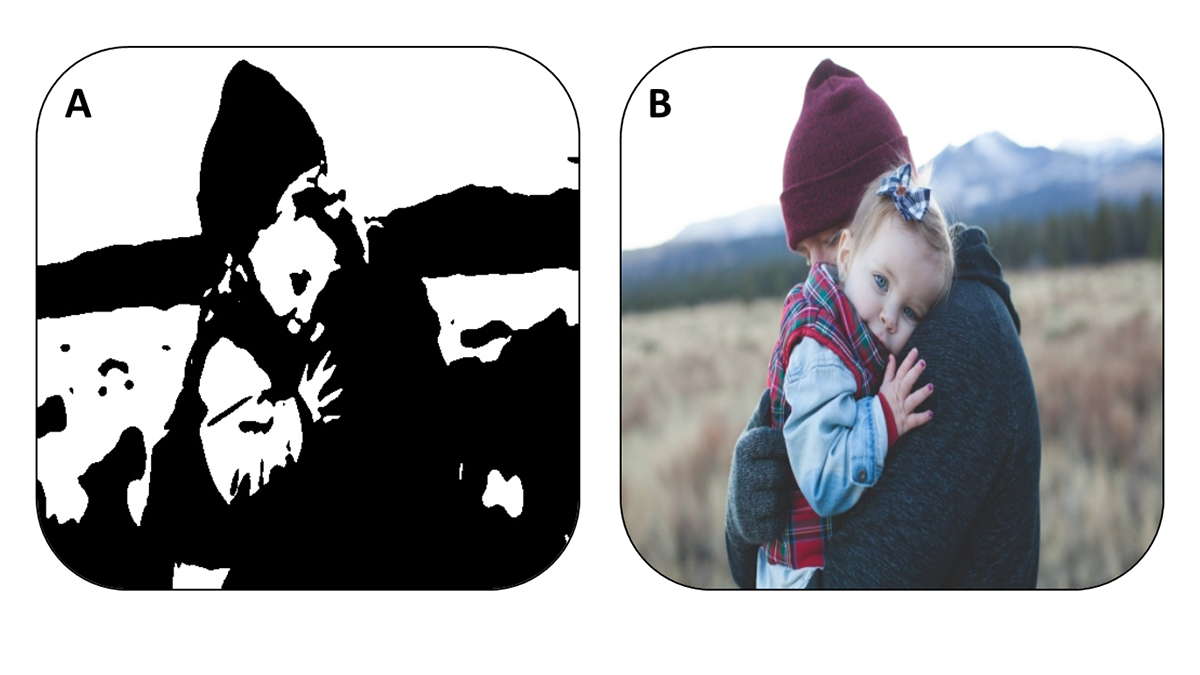Session Information
Date: Wednesday, September 25, 2019
Session Title: Cognition and Cognitive Disorders
Session Time: 1:15pm-2:45pm
Location: Agora 3 East, Level 3
Objective: To test whether increased reliance on prior knowledge is associated with visual hallucinations in Lewy Body Disease (LBD: Parkinson’s disease and Dementia with Lewy bodies).
Background: Visual hallucinations are common and distressing in LBD, occurring in up to 70% of patients (1). Currently their mechanisms are unknown. Recent evidence links hallucinations in psychiatric illness with relatively increased weight accorded to prior knowledge (2). Similar mechanisms may underlie hallucinations in LBD. We used a visual learning paradigm to test sensory integration in LBD-associated hallucinations, specifically use of prior knowledge.
Method: We explored perception of two-tone images, which are difficult to disambiguate without prior information [Fig. 1A] but generate a strong percept once the original colour figure from which they were created is seen [Fig. 1B]. Participants were first shown two-tone images (Fig. 1A) and asked whether each image contained a person. They were then shown the template images (Fig. 1B) and finally the two-tone images were shown again, with the same person-identification task. We measured accuracy before and after viewing the template images in LBD with hallucinations (LBD+VH), LBD without hallucinations and controls.
Results: 57 individuals took part: 17 LBD+VH, 20 LBD without hallucinations and 20 controls; mean age 68.9 years (range 50-83). Groups did not differ in age, gender, low-level vision or cognition (p>0.05). Additionally, LBD with and without hallucinations did not differ in disease duration, motor examination or levodopa equivalent dose. In accordance with our hypothesis, people with LBD-associated hallucinations showed more improvement in performance in discrimination sensitivity (d’) after seeing the template images: 38.1% (from d’=1.41 to 1.95, SD=0.41), compared to 10.1% improvement (from 1.96 to 2.15, SD=0.46) in LBD without hallucinations and 21% in controls (from 1.92 to 2.32, SD=0.37), F= 3.184, p<0.05; posthoc comparison showed significant difference between LBD with and without hallucinations (p<0.05).
Conclusion: People with LBD-associated hallucinations showed greater improvement in performance in a visual task after prior information was provided despite identical sensory evidence, implying greater reliance on prior knowledge. This sheds light onto processes underlying LBD hallucinations and could provide important insights for future therapeutic targets.
References: 1. Weil RS, Schrag AE, Warren JD, Crutch SJ, Lees AJ, Morris HR. Visual dysfunction in Parkinson’s disease. Brain. 2016 Jul 13; 2. Corlett PR, Horga G, Fletcher PC, Alderson-Day B, Schmack K, Powers AR. Hallucinations and Strong Priors. Trends Cogn Sci. 2019 Feb;23(2):114–27.
To cite this abstract in AMA style:
A. Zarkali, R. Adams, L. Leyland, G. Rees, R. Weil. Visual hallucinations in Lewy Body Disease are characterised by impaired sensory integration [abstract]. Mov Disord. 2019; 34 (suppl 2). https://www.mdsabstracts.org/abstract/visual-hallucinations-in-lewy-body-disease-are-characterised-by-impaired-sensory-integration/. Accessed December 14, 2025.« Back to 2019 International Congress
MDS Abstracts - https://www.mdsabstracts.org/abstract/visual-hallucinations-in-lewy-body-disease-are-characterised-by-impaired-sensory-integration/

